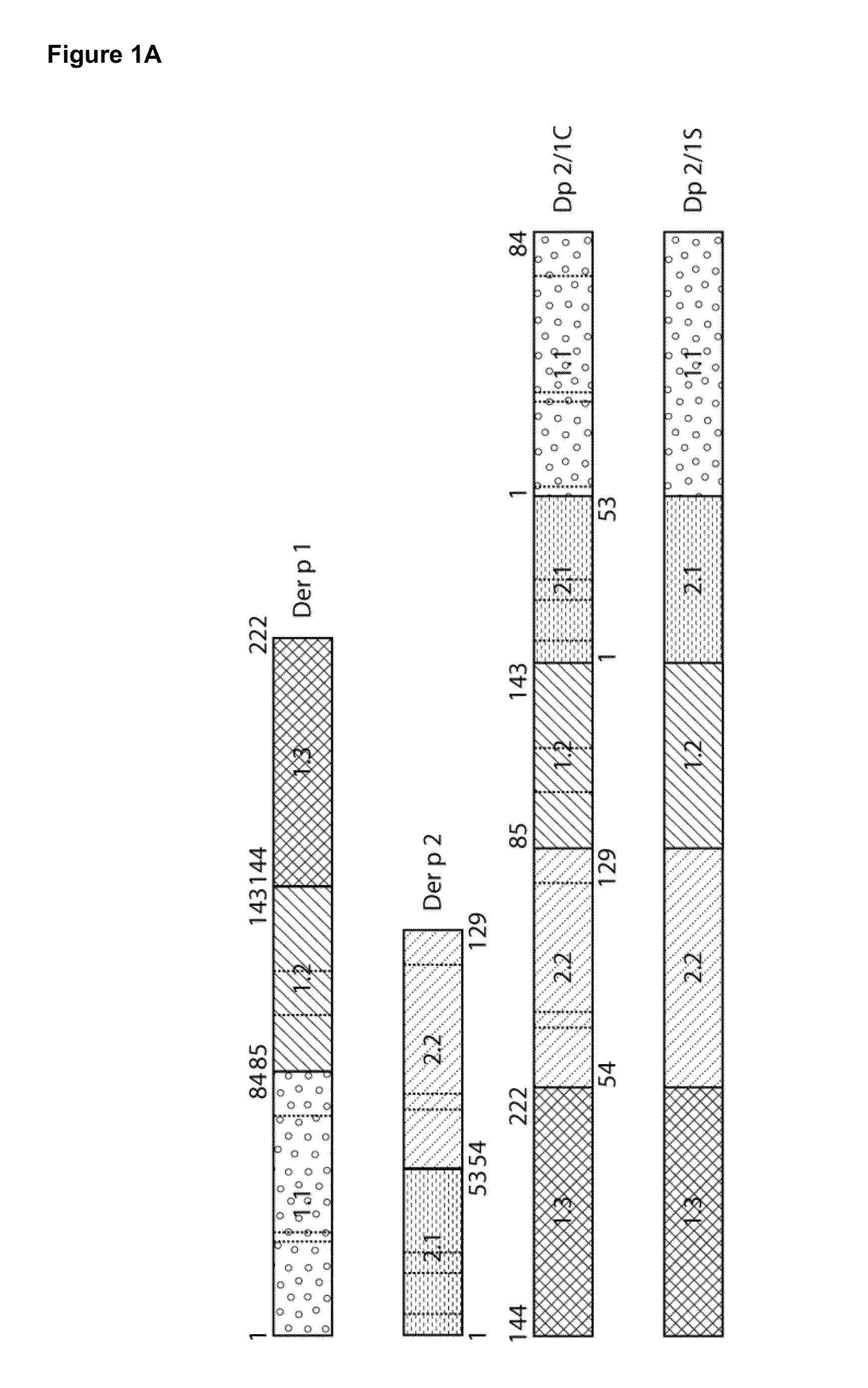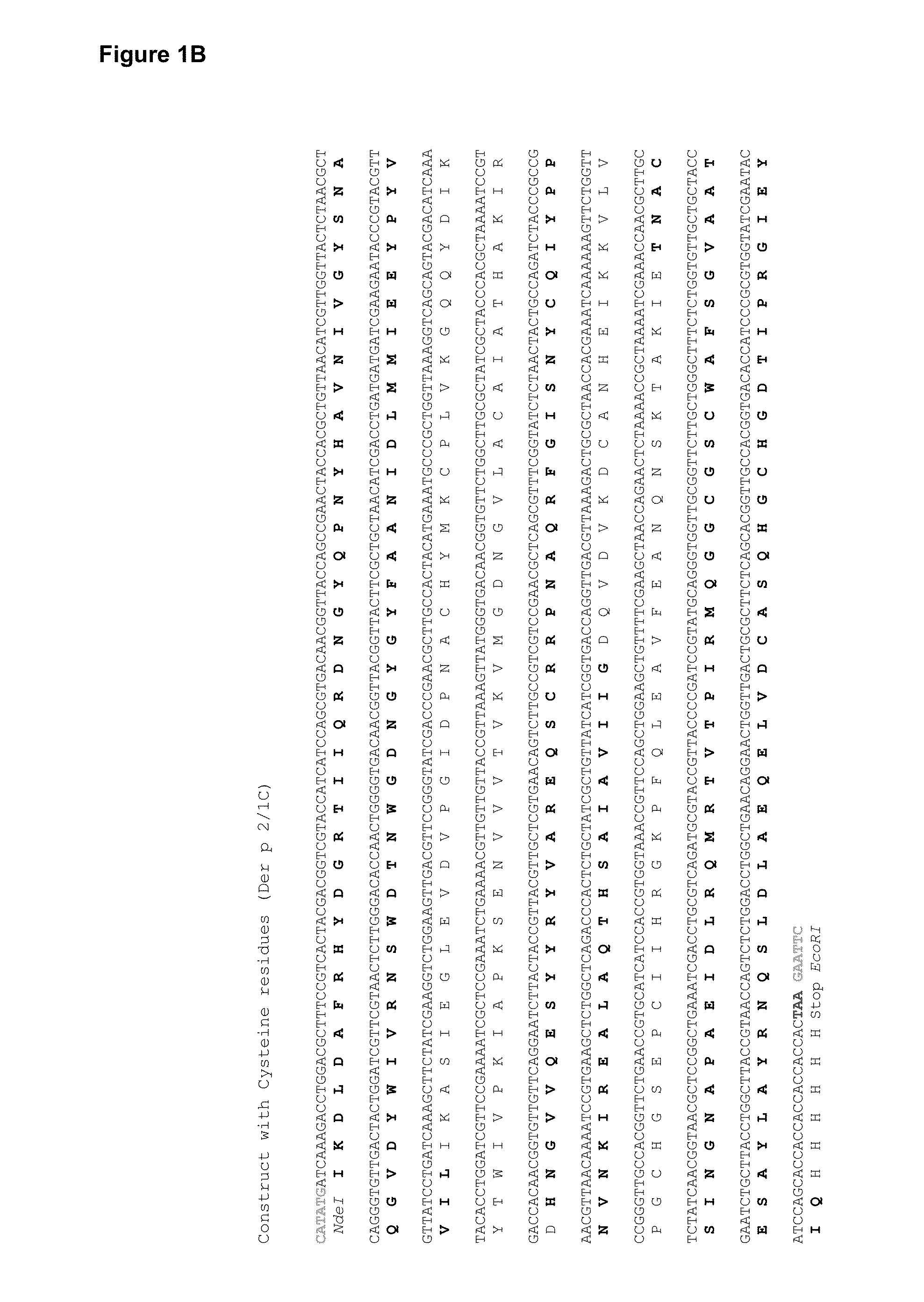Hypoallergenic polypeptides for the treatment of house dust mite allergy
a technology of polypeptides, which is applied in the field of immunotherapy against igemediated allergy, can solve the problems of limiting clinical efficacy and limiting the broad applicability of this treatment in particular for house dust mite allergy
- Summary
- Abstract
- Description
- Claims
- Application Information
AI Technical Summary
Benefits of technology
Problems solved by technology
Method used
Image
Examples
example 1
Construction of Der p 2 / 1 Mosaic Proteins
[0059]To construct the Der p 2 / 1 mosaic protein, three fragments of Der p 1 (1.1 aa1-84; 1.2 aa 85-143; 1.3 aa144-222) and two fragments of Der p 2 (2.1 aa 1-53; 2.2 aa 54-129) were reassembled in the following order: 1.3, 2.2, 1.2, 2.1, 1.1 (FIG. 1A). Two synthetic genes for the Der p 2 / 1 mosaic proteins were synthesized with a C-terminal hexahistidines tag and codon-optimized for the expression in E. coli (ATG biosynthetics, Merzhausen, Germany). One gene contained the DNA coding for the original Der p 1 and Der p 2 aa sequence with the twelve cysteine-residues (Dp 2 / 1C) (FIG. 1B) and in the other gene, the cysteine-residues were exchanged with serine-residues (Dp 2 / 1S) (FIG. 1C). The synthetic genes were cloned into the NdeI / EcoRI fragment of the multiple cloning site of the expression vector pET17b and the DNA sequences were determined by sequencing (ATG biosynthetics).
example 2
Expression and Purification of Der p 2 / 1 Mosaic Proteins
[0060]Expression vectors containing the Der p 2 / 1 constructs were transformed into E. coli strain BL21 (DE3). Protein expression was performed in 250 ml liquid culture by induction with 0.5 mM isopropyl-β-thiogalactopyranoside (IPTG) at an OD600 of 0.8 for 4 h at 37° C. and cells were harvested by centrifugation at 4000×g for 15 min at 4° C. The bacterial pellets obtained from 250 ml liquid culture were resuspended in 10 ml 25 mM imidazol, pH 7.4, 0.1% (v / v) Triton X-100. Cells were lysed by three freeze / thawing cycles (−70° C. / +50° C.), DNA was degraded by incubation with 1 μg DNase I for 10 min at room temperature and cell debris were removed by centrifugation (10,000×g, 30 min, 4° C.). Dp2 / 1C and Dp 2 / 1S mosaic proteins were found in the pellet in the inclusion body fraction, which was solubilised with 6M guanidine hydrochloride, 100 mM NaH2PO4, 10 mM Tris-Cl, pH 8 for 4 h at room temperature. Insoluble residues were removed...
example 3
Characterization of Der p 2 / 1 Mosaic Proteins
[0062]The purity and molecular mass was controlled by SDS-PAGE shown in FIG. 2A. Both mosaic proteins show a clear band at approximately 37 kDa. To achieve information about polymerization behaviour of the mosaic proteins SDS-PAGE was performed under reducing and non-reducing conditions shown in FIG. 2B. For reducing conditions a sample buffer containing β-Mercaptoethanol was used and samples were boiled at 95° C. for 5 minutes, for non-reducing conditions a sample buffer with out β-Mercaptoethanol was used. Under reducing conditions the two Der p 2 / 1 mosaic proteins appear as monomeric proteins (FIG. 2B, lanes r). But under non-reducing conditions the two Der p 2 / 1 mosaic proteins form aggregates, whereas Der p 2 / 1C forms more aggregates than Der p 2 / 1S (FIG. 2B, lanes nr).
[0063]To analyse the protein fold, Circular dichroism (CD) measurements were performed with nDer p 1, rDer p 2, Der p 2 / 1C and with Der p 2 / 1S at protein concentration...
PUM
| Property | Measurement | Unit |
|---|---|---|
| pH | aaaaa | aaaaa |
| pH | aaaaa | aaaaa |
| temperature | aaaaa | aaaaa |
Abstract
Description
Claims
Application Information
 Login to View More
Login to View More - Generate Ideas
- Intellectual Property
- Life Sciences
- Materials
- Tech Scout
- Unparalleled Data Quality
- Higher Quality Content
- 60% Fewer Hallucinations
Browse by: Latest US Patents, China's latest patents, Technical Efficacy Thesaurus, Application Domain, Technology Topic, Popular Technical Reports.
© 2025 PatSnap. All rights reserved.Legal|Privacy policy|Modern Slavery Act Transparency Statement|Sitemap|About US| Contact US: help@patsnap.com



